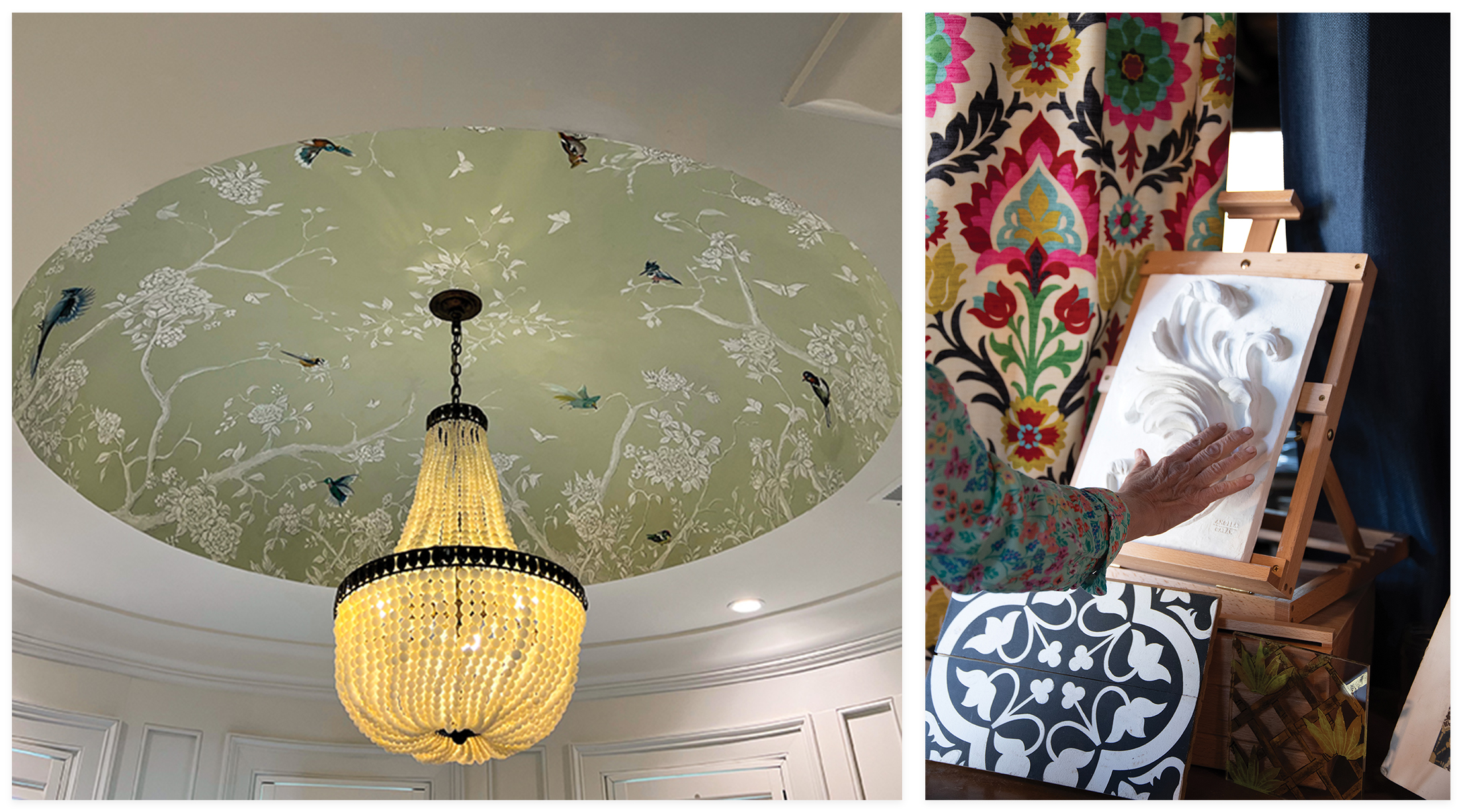The former Broadway performer says her training helps her balance on scaffolding to paint ceilings

As an adjunct professor of plaster and decorative finishes at the American College of the Building Arts, Angela Cabán teaches students classical skills such as marbling, wood-graining, and gilding.
How did a former Broadway performer with credits such as Cats, Some Like It Hot, and Little Shop of Horrors become a sought-after decorative fine artist with projects around the world? Serendipity, says Angela Cabán.
Today, she says her training for Cats helps her balance on scaffolding for hours as she molds floral plaster designs and paints an 18th-century chinoiserie-inspired scene on a concave dome at an Isle of Palms home. Cabán specializes in classical applications such as murals, marbling, wood-graining, gilding, trompe l’oeil, and patinas, and her work has been featured on the pages of Architectural Digest. As the adjunct professor of plaster and decorative finishes at the American College of the Building Arts, she gets to pass old-world skills to new generations of artisans.
When she’s not teaching, the instructor splits her time between Europe and New York, working on projects and continuing to study. In addition to an associate degree in fine arts and a B.A. in restoration from the Fashion Institute of Technology, Cabán has a diploma in interior design from Ivy House Design School in Bath, England, and is a board-certified doctor of Eastern medicine. Here, the renaissance woman shares her artistic journey.
Dancing Queen: I broke my leg when I was four years old and was in a body cast for a long time. They weren’t sure I’d walk again. We didn’t have physical therapy then, so they put me in a dance class, and I loved it. I grew up in Savannah and Washington, DC, and when I graduated from high school, I moved to New York City to be a dancer.

(Left to right) The ceiling Angela Cabán painted for an Isle of Palms home; the artist at her home in Hanahan.
Falling for Interiors: When I was in Cats on Broadway, I used to stop at The Frick [Collection] on my walk home because there was a lovely water fountain. There’s a swanky building next door, and one night, I discovered boxes and boxes of The World of Interiors magazine that someone had thrown out. I walked back, got five more boxes, and carried them to my fourth-floor walk-up. They featured European interiors that weren’t always new; they showed peeling paint, and plaster falling off the wall, and all the crumbly bits. I was in love.
I found out the Fashion Institute of Technology had a restoration program, so I went in person and argued my way in even though I didn’t have a portfolio. At first, I specialized in 18th-century water-gilded antiques; I was working on furniture worth more than my apartment. I love objects, but I found out I really love walls, so I started going to Europe. I still go a couple of times a year to study in places like Italy, the Netherlands, France, or Spain. I did an apprenticeship in St. Petersburg, Russia, and my mentor, Michel Nadaï, lives in France.
Landing in Charleston: The Society of Gilders had a board meeting here, and it felt a little bit like Europe to me. I started teaching, and here I am. I’m spending more and more time in Charleston because I’m teaching five classes and doing commission work. If people want me to work away from Charleston, they have to wait for summer or over Christmas.
Making a Hand-Heart Connection: We all need spaces that are creative, beautiful, and feel safe to live our lives more fully. We need spaces that refresh us. People employ artisans because there’s a hand-heart connection. It’s something special. We’re doing a sgraffito wall here; at first, nobody knew what it was. The more we do these things, the more people see what’s possible. There is something about knowing you’re connected to a lineage of unsung people. We don’t get plaques or singled out in magazines very often, but we’re out there doing the work over and over again.
Trade School: There are so few places where you can learn this trade. There’s a school in Belgium that’s been around since the 1860s, but it’s just decorative painting. The school in Paris closed, and the academy in Florence is teaching restoration but not for new interiors. These trades are dying, so people no longer know how to restore beautiful buildings. That’s why I love the College for the Building Arts and its mission. The kids in my classes are different; I have to kick them out of class in the evenings, and they’re still texting me at 11 p.m.
Teaching Moment: People used to say, ‘Follow your passion, and the money will follow,’ but now they say, ‘Don’t follow your passion, just make money.’ I teach my students to follow their passions, make time to think, noodle, and go see things that have nothing to do with their work. Just go get inspired.